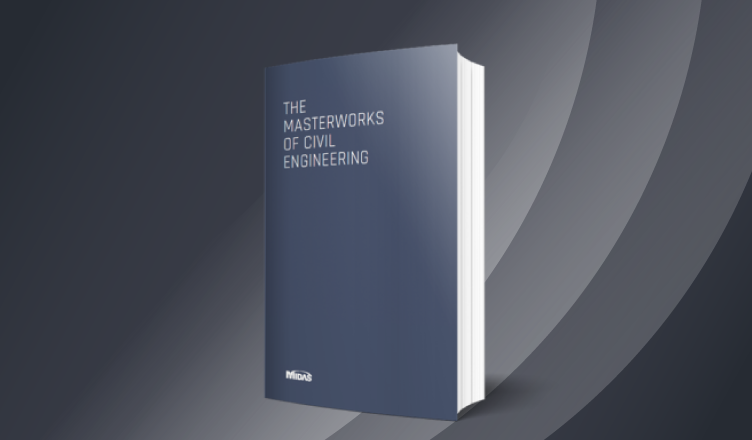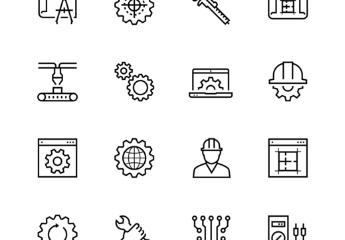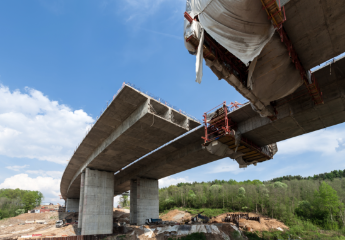Influence line & surface analysis are moving load analysis techniques for bridges used in many structural analysis programs. In this post, we will try to understand the basic contents of these two interpretation techniques.
The moving load analysis function in midas Civil is used to statically analyze and design bridge structures for vehicle moving loads.
Important features are included as follows:
- Generation of influence line and influence surface for displacements, member forces, and reactions due to moving loads
- Calculation of maximum/minimum nodal displacements, member forces, and support reactions for a given moving vehicle load using the generated influence line and influence surface
Moving load analysis of a bridge structure entails a series of analyses for all loading conditions created along the entire moving load path to find the maximum and minimum values, which are used as the results of the moving load case.
In order to carry out a moving load analysis, we define vehicle loads, traffic lanes, or traffic surface lanes and the method of applying the vehicle loads, and then we apply a unit load at various points to traffic lanes or traffic surface lanes to calculate influence line or influence surface.
An Influence line is presented on the traffic lane and represents a specific component of analysis results obtained from static analyses of a bridge structure subjected to a unit load moving along the traffic lane. An influence surface represents a specific component of analysis results obtained from static analyses of the traffic lane plane of a bridge structure subjected to a unit load located at the plate element nodes and is presented on the points of load application. The components of results that can be calculated for influence lines or influence surfaces include nodal displacements of the structural model, member forces for truss, beam and plate elements, and support reactions.
An analysis procedure for a vehicle moving load using influence lines or influence surfaces can be summarized as follows:
1. Define vehicle loads, method of applying the moving loads and traffic lanes or traffic lane surfaces.
2. Calculate influence lines or influence surfaces for each component by performing static analyses for unit loads that are generated by the traffic lane or traffic surface lane.
3. Produce the analysis results due to the vehicle movement using influence line or influence surface according to the moving load application method.
%20What%20is%20the%20Influence%20Line%20and%20Surface%20Analysis%20on%20bridges/Fig1.%20Influence%20line%20diagram.png?width=690&name=Fig1.%20Influence%20line%20diagram.png)
An influence line is calculated by applying a unit load (vertical load or torsional moment) along the traffic lane. Influence lines can be produced for nodal displacements, member forces, and reactions of all nodes, truss, beam and plate elements, and supports included in the model.
An influence surface is calculated from the analysis in which a unit load (vertical load) is applied to the nodes constituting plate elements in a traffic surface lane.
%20What%20is%20the%20Influence%20Line%20and%20Surface%20Analysis%20on%20bridges/Table%201.%20Features%20and%20applications%20of%20influence%20line%20and%20influence%20surface%20analyses.png?width=733&name=Table%201.%20Features%20and%20applications%20of%20influence%20line%20and%20influence%20surface%20analyses.png)
Table 1. Features and applications of influence line and influence surface analyses
Influence Line modeling and analysis results
Modeling procedure
%20What%20is%20the%20Influence%20Line%20and%20Surface%20Analysis%20on%20bridges/Step%201.%20Input%20girder%20bridge%20as%20a%20beam%20element.png?width=607&name=Step%201.%20Input%20girder%20bridge%20as%20a%20beam%20element.png)
%20What%20is%20the%20Influence%20Line%20and%20Surface%20Analysis%20on%20bridges/Step%201.%20Input%20girder%20bridge%20as%20a%20beam%20element.png?width=630&name=Step%201.%20Input%20girder%20bridge%20as%20a%20beam%20element.png) Step 2. Input Bridge support boundary conditions
Step 2. Input Bridge support boundary conditions%20What%20is%20the%20Influence%20Line%20and%20Surface%20Analysis%20on%20bridges/Step%203.%20Input%20Influence%20line%20by%20specifying%20a%20lane..png?width=682&name=Step%203.%20Input%20Influence%20line%20by%20specifying%20a%20lane..png)
%20What%20is%20the%20Influence%20Line%20and%20Surface%20Analysis%20on%20bridges/Step%204.%20Input%20other%20load%20conditions.png?width=653&name=Step%204.%20Input%20other%20load%20conditions.png)
%20What%20is%20the%20Influence%20Line%20and%20Surface%20Analysis%20on%20bridges/Step%205.%20Completed%20Girder%20bridge%20model.png?width=676&name=Step%205.%20Completed%20Girder%20bridge%20model.png)
Analysis results
%20What%20is%20the%20Influence%20Line%20and%20Surface%20Analysis%20on%20bridges/Influence%20line%20on%20the%20deflection%20of%20the%20first%20central%20span.png?width=698&name=Influence%20line%20on%20the%20deflection%20of%20the%20first%20central%20span.png)
%20What%20is%20the%20Influence%20Line%20and%20Surface%20Analysis%20on%20bridges/Influence%20line%20for%20the%20moment%20(My)%20of%20the%20first%20central%20span.png?width=694&name=Influence%20line%20for%20the%20moment%20(My)%20of%20the%20first%20central%20span.png) fig. Influence line for the moment (My) of the first central span
fig. Influence line for the moment (My) of the first central span%20What%20is%20the%20Influence%20Line%20and%20Surface%20Analysis%20on%20bridges/Maximum%20displacement%20due%20to%20vehicle%20moving%20loads.png?width=682&name=Maximum%20displacement%20due%20to%20vehicle%20moving%20loads.png)
%20What%20is%20the%20Influence%20Line%20and%20Surface%20Analysis%20on%20bridges/Maximum%20moment%20(My)%20due%20to%20vehicle%20moving%20loads.png?width=653&name=Maximum%20moment%20(My)%20due%20to%20vehicle%20moving%20loads.png)
Influence Surface modeling and analysis results
Modeling procedure
%20What%20is%20the%20Influence%20Line%20and%20Surface%20Analysis%20on%20bridges/Step%201.%20Input%20Slab%20bridge%20as%20a%20plate%20element.png?width=607&name=Step%201.%20Input%20Slab%20bridge%20as%20a%20plate%20element.png)
%20What%20is%20the%20Influence%20Line%20and%20Surface%20Analysis%20on%20bridges/Step%202.%20Input%20Bridge%20support%20boundary%20conditions-1.png?width=630&name=Step%202.%20Input%20Bridge%20support%20boundary%20conditions-1.png) Step 2. Input Bridge support boundary conditions
Step 2. Input Bridge support boundary conditions%20What%20is%20the%20Influence%20Line%20and%20Surface%20Analysis%20on%20bridges/Step%203.%20Input%20Influence%20surface%20by%20specifying%20a%20lane..png?width=652&name=Step%203.%20Input%20Influence%20surface%20by%20specifying%20a%20lane..png)
%20What%20is%20the%20Influence%20Line%20and%20Surface%20Analysis%20on%20bridges/Step%204.%20Input%20other%20load%20conditions-1.png?width=653&name=Step%204.%20Input%20other%20load%20conditions-1.png)
%20What%20is%20the%20Influence%20Line%20and%20Surface%20Analysis%20on%20bridges/Step%205.%20Completed%20Slab%20Bridge%20Model.png?width=676&name=Step%205.%20Completed%20Slab%20Bridge%20Model.png) Step 5. Completed Slab Bridge Model
Step 5. Completed Slab Bridge Model
Analysis results
%20What%20is%20the%20Influence%20Line%20and%20Surface%20Analysis%20on%20bridges/Influence%20line%20on%20the%20deflection%20of%20the%20first%20central%20span-2.png?width=698&name=Influence%20line%20on%20the%20deflection%20of%20the%20first%20central%20span-2.png)
%20What%20is%20the%20Influence%20Line%20and%20Surface%20Analysis%20on%20bridges/Influence%20line%20on%20the%20deflection%20of%20the%20second%20central%20span.png?width=694&name=Influence%20line%20on%20the%20deflection%20of%20the%20second%20central%20span.png) fig. Influence line on the deflection of the second central span
fig. Influence line on the deflection of the second central span%20What%20is%20the%20Influence%20Line%20and%20Surface%20Analysis%20on%20bridges/Influence%20line%20on%20the%20moment%20(Mxx)%20of%20the%20second%20central%20span.png?width=682&name=Influence%20line%20on%20the%20moment%20(Mxx)%20of%20the%20second%20central%20span.png)
%20What%20is%20the%20Influence%20Line%20and%20Surface%20Analysis%20on%20bridges/Maximum%20displacement%20due%20to%20vehicle%20moving%20loads-2.png?width=653&name=Maximum%20displacement%20due%20to%20vehicle%20moving%20loads-2.png)
%20What%20is%20the%20Influence%20Line%20and%20Surface%20Analysis%20on%20bridges/Maximum%20moment%20(Mxx)%20due%20to%20vehicle%20moving%20loads.png?width=653&name=Maximum%20moment%20(Mxx)%20due%20to%20vehicle%20moving%20loads.png)
The above influence lines or influence surfaces are drawn on the screen or printed out through the Post-Processing Mode.
In Midas Civil, the influence lines or surfaces are used to calculate the structural response due to vehicle moving loads, and the linear interpolation is used for the interval between the load points
 Get Started midas Civil
Get Started midas Civil
 Featured blog of this week
Featured blog of this week










